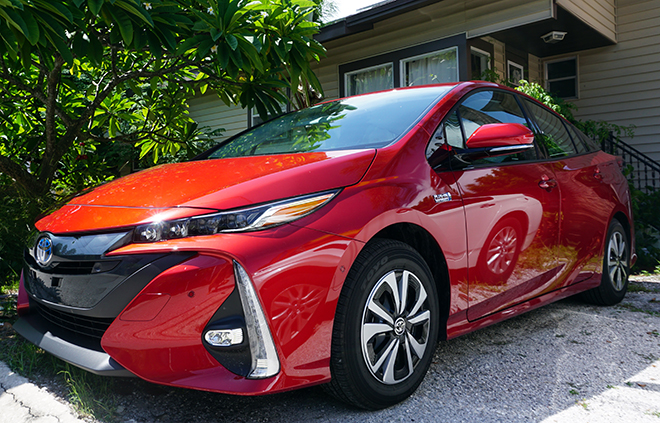Looking for an objective review of the Toyota Prius Prime Advanced? Sorry, you’ll have to look elsewhere. I’m one of “the pious” – annoying Prius drivers who sing the praises of our favorite hybrid vehicle to anyone who will listen. I’ve owned three Prii (and yes, replaced batteries on two), and this is a completely new and vastly improved generation. Several reviewers have called the Prius Prime “the best Prius ever,” and as the Prius is by far the most successful hybrid vehicle in history, it’s not too much to call this the pinnacle of hybrid technology to date.
The reasons I love the Prius are personal, and by no means shared with the majority of car buyers – I want excellent gas mileage and plenty of cargo space for my musical gear. The Prius has long held the undisputed title of the most fuel-efficient car on the road (the Hyundai Ionic temporarily edged it out by a couple of mpg in 2017). And while there are plenty of (much larger) vehicles with more cubic footage of cargo space than the Prius, its combination of a low, flat cargo deck and ample square footage is unmatched by any car of similar size, and even outclasses some SUVs.

The one thing the Prius always lacked was driving pleasure, a tertiary consideration for me, but a fun bonus that the Prius Prime has added in abundance. I’ve been driving a number of PHEVs lately, and this one blows the others away. It rivals the performance of a pure EV, because for 25 miles, it is one.
The greatest thrill of electric driving is that leaping acceleration you get from zero to about 40 mph. No conventional hybrid can deliver that consistently, because whether you’re driving on the electric motor or the gas engine depends on the battery’s state of charge. When you put the pedal down, the gas engine is going to kick in, and the transition is not always smooth, to say the least. Like other hybrids, the Prius Prime will go to the gas engine when you really punch it. However, the transition is as smooth as extra-virgin motor oil, and although the 0-60 time of 10.2 seconds is technically no better than that of the plain old Prius, the initial electric acceleration (0-40 or so) is excellent, as even MotorTrend admits. In EV mode with a trained foot, you can enjoy that all-electric leap until the 25-mile electric range is exhausted.

How did Toyota double the electric range from the older Prius Plug-In? By reducing the cargo space, of course. The Prius Prime’s only drawback in my world is an approximately 2-inch-high hump in the cargo floor. However, after several real-world tests on real-world gigs, I found that my rig still fits with no problem, and I could squeeze in more gear with some creative packing. Since I tested an earlier version of the Prime, Toyota seems to have strengthened the flooring that covers the battery – it isn’t a solid metal floor, but it’s sturdy enough to handle a few years of loading amps in and out. My verdict is that the reduced cargo space is a drawback, but one I could live with in exchange for the better mileage and far superior driving experience.
Speaking of mileage, the 2018 Prime gets 133 MPGe (gas and electric combined) or 54 MPG (gas only) combined, the best of any car on the road (the 2018 Hyundai Ioniq Plug-in Hybrid gets 119/52, so there). Unscientific survey department: I took two 100-mile round trips, fiddling with all the different driving modes and having plenty of electric fun on the highway onramps, and burned about a gallon of gas.

The techno bells and whistles are up to the minute. I like the heads-up display, which shows the speed and remaining electric range, and the cruise control, which is easily selectable between adaptive and normal.
So, how much of a premium will you pay for the joys of plugging in? Well, believe it or not, you might just pay less, not more. The Prius Prime’s MSRP starts at $27,300, and it is eligible for a $4,502 federal tax credit, as well as an additional rebate in some states ($1,500 in California). The plugless Prius starts at $23,475. So, if you can take advantage of the tax credit, you might pay over a grand less to Prime your Prius, in addition to the money you’re going to save on gas.

The Prius Prime has been consistently popular since its November 2016 US launch. It’s currently the second-best-selling plug-in vehicle after the Tesla Model 3. It’s also slowly stealing sales from the legacy Prius – in March it accounted for over 35% of total Prius sales in the US (sales figures courtesy of InsideEVs). That leaves only one question: what were the other 65% thinking?
- Battery: 8.8 kWh
- Engine: 1.8 liters, 95 hp
- Motor: AC synchronous
- Fuel economy: 133 MPGe; 54 MPG combined
- Electric range: 25 miles
- MSRP: Plus: $27,300; Premium: $29,000; Advanced: $33,300. Eligible for $4,502 federal tax credit.




















































